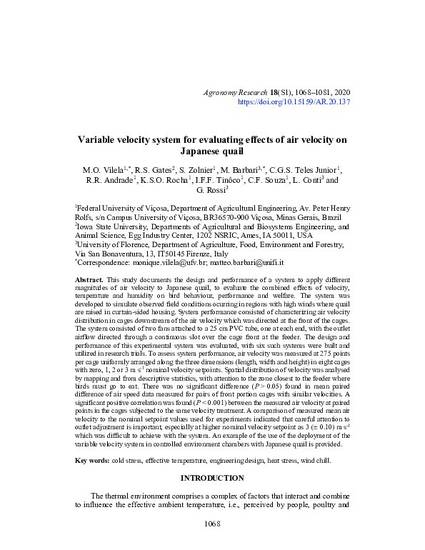
This study documents the design and performance of a system to apply different magnitudes of air velocity to Japanese quail, to evaluate the combined effects of velocity, temperature and humidity on bird behaviour, performance and welfare. The system was developed to simulate observed field conditions ocurring in regions with high winds where quail are raised in curtain-sided housing. System performance consisted of characterizing air velocity distribution in cages downstream of the air velocity which was directed at the front of the cages. The system consisted of two fans attached to a 25 cm PVC tube, one at each end, with the outlet airflow directed through a continuous slot over the cage front at the feeder. The design and performance of this experimental system was evaluated, with six such systems were built and utilized in research trials. To assess system performance, air velocity was measured at 275 points per cage uniformly arranged along the three dimensions (length, width and height) in eight cages with zero, 1, 2 or 3 m s⁻¹ nominal velocity setpoints. Spatial distribution of velocity was analysed by mapping and from descriptive statistics, with attention to the zone closest to the feeder where birds must go to eat. There was no significant difference (P > 0.05) found in mean paired difference of air speed data measured for pairs of front portion cages with similar velocities. A significant positive correlation was found (P < 0.001) between the measured air velocity at paired points in the cages subjected to the same velocity treatment. A comparison of measured mean air velocity to the nominal setpoint values used for experiments indicated that careful attention to outlet adjustment is important, especially at higher nominal velocity setpoint as 3 (± 0.10) m s⁻¹ which was difficult to achieve with the system. An example of the use of the deployment of the variable velocity system in controlled environment chambers with Japanese quail is provided.
Available at: http://works.bepress.com/richard-gates/74/

This article is published as Vilela, M. O., R.S. Gates, S. Zolnier, M. Barbari, C.G.S. Teles Junior, R.R. Andrade, K.S.O. Rocha, I.F.F. Tinoco, C.F. Souza, L. Conti, and G. Rossi. 2020. Variable velocity system for evaluating effects of air velocity on Japanese quail. Agronomy Research 18(S1):1068-1081. doi: 10.15159/AR.20.137.